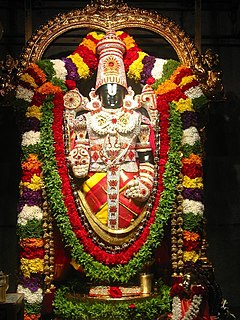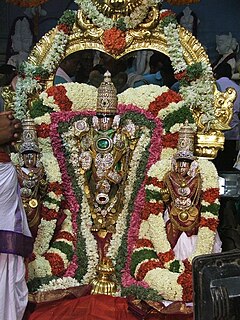
Venkateshvara, also known by various other names, is a form of the Hindu god Vishnu. Venkateshvara is the presiding deity of Tirumala Venkateshvara Temple located in Tirupati, Andhra Pradesh, India.

Tirumala is a spiritual town in Tirupati district of the Indian state of Andhra Pradesh. It is one of the suburbs of the Tirupati urban agglomeration. The town is a part of Tirupati Urban Development Authority and located in Tirupati (rural) mandal of Tirupati revenue division. It is a hill town where Tirumala Venkateswara Temple is located, which is the abode of Venkateswara. The town is strictly vegetarian.

Sri Varaha Lakshmi Narasimha temple, Simhachalam is a Hindu temple situated on the Simhachalam Hill Range, which is 300 metres above the sea level in Visakhapatnam, Andhra Pradesh, India. It is dedicated to Vishnu, who is worshipped there as Varaha Narasimha. As per the temple's legend, Vishnu manifested in this form after saving his devotee Prahlada from a murder attempt by the latter's father Hiranyakashipu. Except on Akshaya Trutiya, the idol of Varaha Narasimha is covered with sandalwood paste throughout the year, which makes it resemble a linga.

Sri Venkateswara Swami vari Brahmotsavam or Srivari Brahmotsavam is the most significant annual fête celebrated at the Venkateswara Temple in Tirumala-Tirupati, Chittoor district, Andhra Pradesh, India. The feast lasts for one month during the Hindu calendar month of Āśvina, which falls between the Gregorian calendar months of September and October.

Sri Venkateswara Swami Vaari Temple is a Hindu temple situated in the hill town of Tirumala at Tirupati in Tirupati district of Andhra Pradesh, India. The Temple is dedicated to Venkateswara, a form of Vishnu, who is believed to have appeared on the earth to save mankind from trials and troubles of Kali Yuga. Hence the place has also got the name Kaliyuga Vaikuntha and the Lord here is referred to as Kaliyuga Prathyaksha Daivam. The temple is also known by other names like Tirumala Temple, Tirupati Temple and Tirupati Balaji Temple. Venkateswara is known by many other names: Balaji, Govinda, and Srinivasa. The temple is run by Tirumala Tirupati Devasthanams (TTD), which is under control of Andhra Pradesh Government. The head of TTD is appointed by Andhra Pradesh Government. The revenue from this shrine is used by Andhra Pradesh government.

Malayappa Swami is the current utsava murti in the Tirumala Venkateswara Temple, Tirumala. Malayappa Swami is worshipped during religious ceremonies and processions wherein it would be inappropriate to use the main deity. The two deities are worshipped equally and believed to be non-different in personality.
For one of the major Hindu denominations, the Tirumala Sri Venkateswara Temple at Tirupati in the Indian state of Andhra Pradesh is the most famous Vaishnavite temple in the world. The presiding deity of Vishnu here is referred to as Venkateswara. There are many legends regarding this temple. Sri Venkatachala Mahatyam is the most accepted legend among these, which provides the history of the temple across the various yugas. This place had also been mentioned in many puranas. It has been said as "Venkatadri samasthanam Brahmande nasti kinchana, Venkatesha samodevo na bhuto na bhavishyati" which literally translates as There is no place in the entire Universe which is equal to Tirumala and there is no other God equal to Venkatesha in the past, present or will be in the future.

Koluvu Srinivasa is an idol of Lord Venkateswara in the Tirumala Venkateswara Temple, Andhra Pradesh. This silver idol that resembles the main deity represents the presiding officer for all activities and rituals in the temple. Koluvu Srinivasa is regarded as the guardian deity of the temple and presides over all its financial and economic affairs. The idol is also called as Bali Bera. The duties of the Bali Bera closely resemble that of the householder. He manages the finances and accounts, and his permission is sought before offering Bali to Nityasuris like Garuda, Hanuman and Vishvaksena on the Balipeetham. There is no recorded history of the deity leaving the innermost 16-pillared hall.

Tirumala Krishna idol is one of the idols in the Tirumala Venkateswara Temple, Andhra Pradesh, India. While the temple is dedicated to worship of lord Vishnu as Venkateswara, it contains the idols of some of Vishnu's other avatars - Krishna and Rama. The temple also has the idol of Rukmini, wife of Lord Krishna.

Tirumala Rama idol is one of the deities in the Tirumala Venkateswara Temple, Andhra Pradesh. While the temple is dedicated to worship of lord Vishnu as Venkateswara, it contains the idols of some of Vishnu's other avatars: Rama and Krishna. The idol is usually accompanied by his consort Sita and his brother Lakshmana.
Tirumala Dhruva Bera is the name given to the deity of Lord Venkateswara in Tirumala Venkateswara Temple, Andhra Pradesh. Dhruva Bera is the official terminology used for the main deity of a temple with the exact translation being The Immobile image and as the name suggests, the deity is stationary and other deities are used for pujas, sevas that requires the deity's presence outside the garbha griham. Other terms used for Dhruva Bera include Moolavar or Moola Virat, Achala (Stagnant).

Vasanthotsavam is an annual Seva celebrated in Tirumala to celebrate the arrival of spring season.

Abhideyaka Abhishekam is a festival conducted in the Tirumala Venkateswara Temple, Andhra Pradesh in India. The purpose of the festival is to conduct special Abhishekam to protect the Utsava deities - Lord Malayappa swami and his consorts Sridevi and Bhudevi from damage that might occur while conducting processions and Tirumanjanam.
Sri Venkateshwara Swami Temple is a landmark vaishnavite temple situated in the hill town of Tirumala at Tirupati in Chittoor district of Andhra Pradesh, India. The Temple is dedicated to Lord Venkateswara, an incarnation of Vishnu, who is believed to be appeared here to save mankind from the trials and troubles of Kali Yuga.
Vaikunta Ekadashi is a special Ekādaśī. It coincides with Mokṣadā Ekādaśī or Putrada Ekādaśī. It is observed on the 11th lunar day of the waxing lunar fortnight of the solar month of Dhanu. This falls between 16 December and 13 January in the English calendar.
Purattasi Sani or Tirumala Shanivara is a Hindu festival celebrated in some parts of South India including Andhra Pradesh, Karnataka, Tamil Nadu and Kerala. The Hindu deity, Venkateswara, is worshiped during this festival. It is celebrated during the Tamil month of Purattasi, which generally falls in the months of September and October of the Gregorian calendar. Puratasi Masam is of great importance as it is believed that Lord Venkateswara appeared on the earth in this month. Lord Vishnu devotees consider this as the ideal month for thanking Lord Vishnu for preserving the Universe at the end of Kali Yuga. All the Saturdays of this month are treated as holy days and Devotees gather in large number at Lord Vishnu temples and special prayers are offered. Particularly the Odd Saturdays first, third, fifth are of more importance. Tirumala Annual Navarathri Brahmotsavam were also observed during this month where Tirumala will be flooded with lakhs of devotees. Some people will take only vegetarian food during this month.

Sri Kodandaramaswamy Temple is one of the famous temples, after Tirumala Venkateswara Temple, in the holy city of Tirupati in Tirupati district of Andhra Pradesh, India. The temple is dedicated to Lord Rama an incarnation of Vishnu along with Sita and Lakshmana. The temple also has a sub-shrine for Anjaneya the mount of Lord Sri Rama.

Vedanarayana Temple or Matsya Narayana Temple is a Hindu temple in Nagalapuram, Andhra Pradesh, India. It is a Vaishnava temple is dedicated to Lord Vishnu in the form of Matsya, the fish avatar, who is referred to as Matsya Narayana or Veda Narayana. This is one of the few temples in India where Lord Vishnu is depicted in Matsya avatar, the first incarnation of the Dashavatara, Lord Vishnu's 10 main incarnations.

Venkateswara Temple is a Vaishnavite temple situated in the town of Dwaraka Tirumala of Eluru district of the Indian state of Andhra Pradesh. The temple is dedicated to Lord Venkateswara, an incarnation of Vishnu. The temple is also known by other name like Chinna Tirupati meaning Small Tirupati.
Venkateswara Temple is an important Vaishnavite temple situated in the hill town of Tirumala in Tirupati district of Andhra Pradesh, India. The Temple is dedicated to Lord Venkateswara, an incarnation of Vishnu, who is believed to be appeared here to save mankind from the trials and troubles of Kali Yuga. The temple is situated at a height of 853 metres on Tirumala Hills which are part of Seshachalam Hills and is constructed in Dravidian Architectural Style.
















